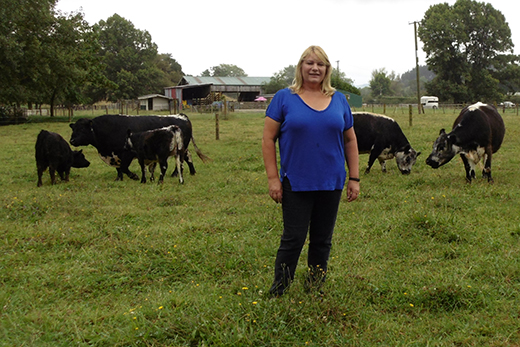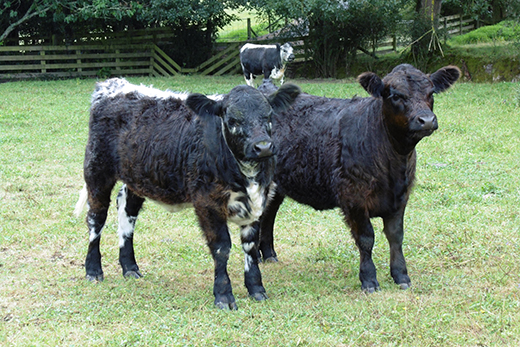Beth McVerry’s determination and love of her Cambridge-based Riggit Galloway herd is finally showing results. What started out with one Riggit has now led to more than 40 with two distinct bloodlines.
Beth has been working for 10 years to get the Riggit Galloway recognised and registered in New Zealand. Now, finally, the herd and the Riggit Galloway cattle has its own ‘herd book’ and acknowledgement of the rare breed.
Originally from Scotland with documented 1740 evidence, the Riggit Galloway and solid black were the true Galloway cattle and the white and belted came later.
A Riggit Galloway is a black – and rarely a red – with a distinctive white stripe down the backbone. Some have white speckled face or a plain black face with white teardrops. The Belted Galloways are black with a distinct white belt.
There is a famous Riggit painting or engraving of George Garrards ‘Fat Galloway Heifer’ dated 1799-1814.
The breed was reintroduced into the United Kingdom in the 1980s where there is a substantial herd book that documents the breed.
There are four types of Galloway – black, white with black points, Belted Galloway bred from crossing Dutch Belt, and the Riggit – white markings down the backbone.
A solid black and a marked Riggit calf – in the background is mother of the solid black calf – Cherrybank Rosie, the first purebred female Riggit in New Zealand.
Double coat
All Galloways have a ‘double’ coat, they are naturally polled – with no horns – medium-framed, possess excellent mothering skills and they do very well on hard ground – foraging on roughage or poor terrain.
In 2007 Beth owned a couple of White Galloways on her and husband Paul’s lifestyle block just south of Cambridge. She saw an advertisement for a solid black Galloway and in the advert it mentioned Riggit. She Googled ‘Riggit’ and started on what was to become extensive research.
Although she missed out on buying the solid black bull she managed to lease the father ‘Ngutunui White Dunmore’ – a purebred Galloway – but it was not registered because New Zealand did not recognise the Riggit breed.
Beth decided to breed and keep the Riggit ‘throwbacks’ while pursuing the aim of registration and ultimately a New Zealand Herd Book for the rare breed.
Her first bull purchase was ‘Cherrybank Dunstan’, a black Riggit. She then purchased ‘Riland Ranger’ and he is now fathering Beth’s Riggit cows. The herd now has five Riggit generations with two different genetic lines.

Beth McVerry is proud of her Riggit Galloway herd.
Imported semen
This year Beth is importing semen from a United Kingdom Riggit Galloway bull – ‘Clifton Red Pride’.
“He is an outstanding bull and will add another dimension, another genetic line that will further improve our herd.”
Through all her research and determination, it is the temperament of the animal which is paramount.
“It is so important to have a kind, easy to handle animal, especially on a lifestyle block,” says Beth.
“Dunstan’s temperament was outstanding so when I look at any animal I want an outstanding animal – all the right physical attributes, but most important is their attitude. It must be good.”
It is down to Beth’s determination that New Zealand now has a NZ Herd Book and the future animals can be recorded.
All animals put forward for inclusion must have an independent inspection on-farm to determine their soundness, true to type, hardy coat, polled, stocky, and docile features. They are photographed and verified and then all details along with photographs and registration papers are sent to the UK.
“We now have our own New Zealand Herd Book, which sits alongside the ‘UK Riggit Herd Book’ with correct criteria and the history of the breed will be preserved.”
Immaculate records
Beth has worked hard to keep immaculate records to ensure the breed can continue and be authentic.
“It’s not just memory – everything is documented, which will give the credibility for a rare breed.”
She hopes by doing this other Galloway breeders will keep any Riggit Galloways, which might appear in their herds.
“They [Riggits] continue to be produced when breeding either the white or black Galloways, which shows just how strong the Riggit line is.
“I feel responsible for the formation of the Riggit Galloway in New Zealand and I am determined they will be right – not just coloured but will also have all the correct attributes of a Galloway.”



0 Comments
Leave a Comment